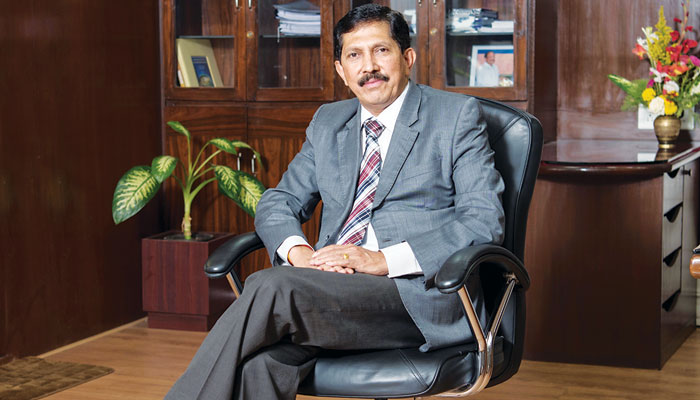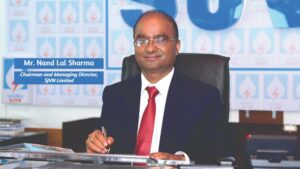Very few quarterly results, announced recently, have drawn investor’s attention, and Bank of Maharashtra’s was one. The bank has entered into a phenomenal growth trajectory with a four-fold increase in its net profit. Obviously the attention was also drawn towards the man leading the team that made it possible in such a gloomy situation that the Indian banking sector is passing through. It was the result of some bold initiatives.
Having gained vast experience at three prominent banks, namely Syndicate Bank, Vijaya Bank and Indian Bank, Mr AS Rajeev, immediately after taking over charge as Managing Director & Chief Executive Officer in December 2018, took some very path-breaking steps at Bank of Maharashtra. He is a qualified Chartered Accountant and aware of all the intricacies one needs to know about managing finance.
In his three decades of previous stints, Mr AS Rajeev got vast exposure and earned expertise in all important areas of banking, including corporate credit, international banking, treasury, risk management, credit monitoring and supervision, NPA management, planning and development, human resources, vigilance, corporate governance, inspection and audit, cyber security and subsidiaries finance, among others. He has also worked as member of various committees constituted by RBI/Government. Always ready to adopt new technology, he has attended various professional training programmes, including on Advanced Leadership, EDP, Risk Management, IFRS, Financing Infrastructure Projects, Derivatives, etc.
In a freewheeling conversation with Indian Economy & Market, he shares various recent initiatives and the future plans.
First of all, congratulations for being adjudged first amongst Public Sector banks for digital transactions. What are the measures taken by the management to strengthen its digital transaction capabilities?
The digital banking choices are expanding exponentially. It became imperative for the bank to recognize this digital change and act promptly to fulfill the growing digital needs of customers. Bank has revamped its digital offerings and solutions in tune with the rapidly changing market requirements. Bank has put sincere efforts in order to make its digital products customer centric and more secure. The Bank catered certain set of arrangements at broader level so as to remove the hindrances imposed while moving ahead in digital ecosystem. The first strategic step towards this was to set up a separate Digital Banking vertical headed by senior level executive having vast experience in Information Technology. A team with blend of technology, analysts and domain expertise is being nurtured to not only implement the digitally-savvy products but to design the products with keeping customer at the centre.
In order to increase the digital footprint, we also conducted various customer engagements to understand their expectation levels in the changed context and worked on re-designing the customer journeys on digital channels. We’ve designed a roadmap for hassle-free customer onboarding on various channels with the help of analytics. Another important aspect is system resilience. Here the challenge was to bring the Technical Declines under control. The team monitored TDS on hourly and daily basis which helped them to bring the system resilience up. With exponential increase in UPI transactions and also other digital channels such as AEPS and e-commerce, the necessary augmentation of infrastructure was accomplished. Additionally, we identified the bottlenecks by engaging all the partners which helped to optimise the systems and achieve the system resilience well.
The bank under your leadership has posted excellent set of numbers for the second quarter of FY20. You reported over four-fold jump in net profit. What are the factors you attribute for this and how sustainable is this?
The Bank has reported total net profit of Rs195.75 crore for first half year ended on September 30, 2019 as compared to loss of Rs1092.00 crore in the same period last year. Profit has also improved on quarter on quarter basis, as our Net Profit was Rs114.66 crore in September 2019 compared to Rs81.09 crore in June 2019 quarter. This is a growth of around 29%.
To answer the second part of your question, I would say the Bank’s performance has improved in view of low cost of deposit on account of higher CASA, intensive recovery efforts resulting in higher recovery, higher treasury income, controlling the expenditures and arresting the slippages. Our growth is sustainable being the outcome of hard work and dedication from our staff. We have made our products, services, policies and procedures customer friendly and competitive enough. We rigorously follow up for the recovery of bad loans and keep monitoring our existing credit portfolio to stop new slippages in future.
There is marked improvement in the quality of your assets. Can you specify the reasons for such improvement?
We have improved the underwriting process by way of improved policy framework, strengthening the internal credit assessment process, strengthening of our Central Processing Cells and improving skill sets of the credit team. At the Head Office level we have a Credit Marketing Cell for mobilizing quality advances and going forward, the same will be replicated to zone level. Bank has formed a Project Appraisal Cell, to improve the quality advances and speedy disposal of the quality proposals. The Bank has adopted Corporate Finance Branch model for lending to Corporate Sector and accordingly designated 34 branches from all the zones as Corporate Finance branches.
Further, we’ve tied up with specialised monitoring agencies for loans above Rs250 crore. To scout quality MSME proposal and its speedy disposal, we’ve identified 50 MSME Specialised Branches. We have also formed 120 retail elite branches to focus the retail credit. Along with this we’ve introduced number of customized products to scout retail and MSME business such as Mahabank Lease Rental Discounting Scheme for Landlords, Mahabank GST Credit Scheme for MSMEs, Mahabank Schemes for Contractors, Mahabank Scheme for units engaged in Hospitality etc. We aim at growing our loan book by about 8-10% in FY20.

What are the efforts you are taking to speed up the recovery of loans?
First of all I must make it clear that about 50 per cent of our impaired assets are under the NCLT purview where resolution process in some of the accounts is at a very advanced stage and is likely to result in recovery soon. To have focused recovery efforts, the Bank has opened four Stressed Asset Management (SAM) branches at Delhi, Mumbai, Pune and Hyderabad. This will speed up the recovery process of large NPA accounts. Out of the total about Rs15,400 crore NPA, nearly 50% are being managed by these four branches. Bank has also established a SAM Vertical (SAMV) at Head Office to monitor the recovery progress in large borrowal NPA Accounts and also functioning of SAM Branches. So far as small impaired assets are concerned we are strengthening the SARFAESI actions, revamping the processing of taking services of recovery agents and enforcement agents. Bank also has a non-discriminatory non-discretionary OTS policy, which is found to be in the interest of all stakeholders and has resulted in quite a few quick recoveries. In addition we are considering the sale of NPAs to ARCs.
Is there any special effort?
Yes, let me tell you about some of our out-of the box steps, like opening of 4 SAM Branches to monitor the NPA Accounts. We have also launched two special OTS Schemes, namely Ghar Ghar Dastak Yojana which is for small borrowers having ledger balance up to Rs25 lakhs; and Maha Riyayat OTS Scheme for those having ledger balance more than Rs25 lakhs and up to Rs50 crore. We are conducting Special Mahabank Adalats at Zonal level. Large accounts are locked in NCLT process, but the bank is concentrating recovery in small borrowal NPA accounts. With very good results, we’re conducting Mahabank Adalats having ledger Balance up to Rs1 crore. Our Special Recovery Camps, which is conducted in all branches across the country on 2nd & 4th Thursday of every month we have recovered more than Rs200 crore. There is again a Special Drive on NPA Reduction. In September and November 2019, we conducted three such camps and it is continuing.
With economy showing signs of moderation, how is it going to impact your credit growth? How do you see fee-based and other income growing?
In the current environment, large infrastructure projects are not moving as per the desired pace and it appears that the growth rate has bottomed out. Although the upside is now probably lower as markets have become more sanguine on recession. As a consequence, demand for large-ticket borrowing continues to be low and hence we’re focusing on the high yield RAM Advances and increasing exposure towards NBFCs more particularly direct assignment of pool of high rated NBFCs. I feel corporate tax cut will lead to better performance and it will definitely boost sentiment for investment. Secondly, with continued thrust on RAM advances bank has witnessed y-o-y growth of 10.20% as on September 30, 2019, which was Rs49,644 crore as against Rs45,050 crore as on September 30, 2018. Thirdly, during the CFY the Bank has focused on the acquisition of Housing/MFI/SME/Agri loans via direct assignment basis of well rated Housing finance Companies and NBFC’s. On fee-based front, we’ve tied up with LIC, Aviva Life Insurance, United India Insurance, Future Generali General Insurance Company and Manipal Cigna Health Insurance for cross selling of their products. Lastly, small savings schemes like PPF, Senior Citizen Savings Scheme and Sukanya Samriddhi scheme are offered. Customers avail National Pension System. Recently we have rationalized service charges in line with the industry.
How do you see 10% minimum exposure in a group loan as stated by the Department of Financial Services, for the bank’s loan growth?
I think banks find it safer to join a consortium because of inherent benefits. Sizable exposure with strong decision making power in the consortium would facilitate to improve the quality assets. Further, consortium with limited participants will facilitate faster and qualitative decision. We’ve our own Project Appraisal Cell at head office to address the issue. We’re strengthening in house underwriting skills and have designated corporate finance branches.
Are you looking to raise capital, what will be the route?
In FY2018-19, government infused Rs4498 crore in December 2018 and Rs205 crore in February. With this government’s share increased to 92.49% as on June 30, 2019. We also raised Rs131.70 crore in FY2019-20 by way of Employee Stock Purchase Scheme. Now we intend to raise Tier II Capital amounting to Rs500 to Rs1000 crore by issuing BASELIII Compliant bonds at the opportune time.
What is your take on interest rate trajectory? If one assumes that interest rates will be lower, how will it impact your bank? Do the NIMs come under pressure?
Recent spike in CPI inflation is mainly on account of rise in food prices. However, good monsoon is expected to cool down the food prices due to good Rabi crop. Therefore, it appears to be seasonal than structural in nature. The interest rate is expected to remain stable or on lower trajectory. Lower interest rate will allow the Bank to keep the cost of deposit at lower rate. We have to pass some benefit of lower interest to borrower, but overall it will improve our NIM. We don’t expect any pressure on NIM.
What is your outlook on loan growth and the slippages playing out?
We expect Credit Growth of 8-10% with the help of improved underwriting process and by strengthening the internal credit process. We have mainly focused on RAM (Retail, Agriculture and MSME). During the first half of the current financial year the slippages were `1770 crore. We expect significant reduction during the second half with the help of robust monitoring system and follow up mechanism.
Technology is becoming a big differentiator now for banks. What steps you’ve taken to leverage Artificial Intelligence and Blockchain?
I fully agree that the inclusion of new technologies is bringing a major change. We’ve put in place a board approved roadmap for deployment of Artificial Intelligence (AI), Machine Learning (ML) and Analytics especially for risk management, compliance management and fraud control. Bank is already in process of establishing Innovation hub/Centre of Excellence to leverage new technologies in order to augment its business capabilities. We also have joined block chain group consisting of other public sector banks. There are some use cases on which bank is already working upon like C-KYC in order to reduce multiple KYC of a customer and marketing of KYC data and Invoice discounting in order to reduce frauds and multiple funding.
What measures are being undertaken to prevent digital banking frauds?
Yes, that’s a challenge. These are getting aggravated because of various factors such as rapidly evolving technologies, use of third party vendors or increased usage of mobile apps by customers including rapid growth of Internet of Things. It has become an absolute need for the bank to be prepared with the cutting edge technology solution to address the security and privacy concerns of customers. Customer awareness is one area we are focusing and we regularly conduct customer awareness programmes. We have established state-of-art Cyber Security Operations Centre (CSOC) that operates 24×7 and keeps a tab on anomalies in the network.
We have Mahasecure, our Internet Banking application secured by REL-ID, which comes with multi-factor authentication. We’ve also implemented a Fraud Risk Management Solution that helps combat debit card fraud. The solution analyses the transaction in near real time and allows the security team to take actions quickly wherever suspicious transactions are identified using the power of its fully configurable rules engine, comprehensive research and decisive capabilities, reporting and case management features. Now we are also working on implementing enterprise wide Fraud Risk Management System (eFRMS) that spans all the delivery channels.






















